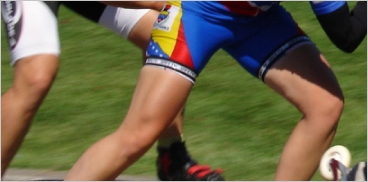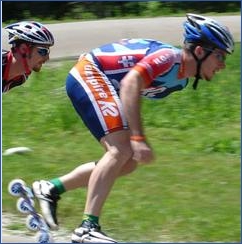 | ||
| ||||||||
Knee and ankle bend for skaters By Peter Doucet There are two very important angles in inline skating. One is the angle of the foot to the calf, which depends on how much you bend your ankles. The other is the angle of your lower leg to your upper leg, which depends on how much you bend your knees. Bending your ankle pushes your knee forward. Bending your knee brings your thigh closer to the ground. So What? Together, deep knee bend and deep ankle bend will turbo-charge your skating. They do this by, in effect, putting your legs into a compressed position, ready to pounce like a coiled snake. Think about it: With legs straight — in other words, without knee bend — you cannot push. (In fact, you can't move, except maybe to fall.) The reason for this is that the power of a push comes from the energy stored in the bent knee and ankle. Aside from lengthening your stride, knee and ankle bend puts you in a more balanced and streamlined skating position and takes some of the load off your back. But ... The reason skaters don't spend more time in a low position is that it's tiring. It's a test of a strength and endurance. But here's the good news: you don't have to stay in a low position all the time. You can save it for when you need all your power, such as at the end of a race. In fact, it's not a good idea to stay in a low position too much of the time. If you do, you could end up without enough gas in the tank for the final sprint, where most races are decided. Becoming a Low Rider You can learn to skate low by taking a "quality over quantity" approach to training. To do this, focus on technique rather than distance skated and keep thinking about being low. Some skaters make the mistake of only bending the knees. To make sure you also bend your ankles, notice where your knees are in relation to your toes. (The more you bend your ankles, the more your knees will move forward.) You should feel your lower calves pushing into the tongues of your boots. Focus To learn to skate low, use short, concentrated training sessions that focus on technique. Here's a good 20-minute interval workout that will help get you lower: Skate for one minute with a deep knee and ankle bend, followed by one minute of rest. Repeat 10 times. Don't push yourself past the point where your "good" technique starts to crumble. It takes strength and balance to maintain the low position. And once you get tired, you are likely to lose it. Off Skates
Dry land exercises can help develop the strength needed to stay low. Squats are great for developing strength. (See squat tip.) Use a mirror or camcorder to make sure your knees are forward and your hamstrings (back of upper legs) are parallel to the ground. Dry land skating is also helpful. Just make sure you don't "pop" your hips up as you are stepping from one leg to the other. Instead, keep them low. Well, that's the ... uh ... lowdown. ... Now get out there and skate!
Related reading: • Skate Tip of the Week Archive
...
Copyright © 2007 by Robert Burnson | ||||||||


